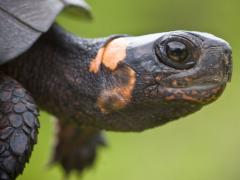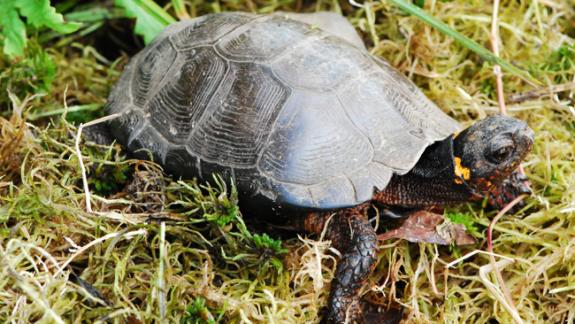New Jersey Endangered and Threatened Species Field Guide
 Zoom+ A juvenile Bog turtle. © Brian Zarate
Zoom+ A juvenile Bog turtle. © Brian ZarateBog turtle
Glyptemys muhlenbergii
Species Group: Reptile
Conservation Status
State: Endangered
Federal: Threatened
Identification
Bog turtles are one of the smallest and most secretive of North American turtles, measuring up to 4 inches as adults. The bog turtle is dark brown with a distinct orange patch on either side of the head. The scutes (scale-like horny layers) of the carapace, or upper shell, are brown or black; they may have yellow or reddish centers. Likewise, the plastron, or underneath shell, is brownish-black with a light yellow center. The limbs are brown and may be mottled with variable amounts of dark yellow, orange, or red blotching. The male bog turtle has a concave plastron while that of the female is flat or slightly convex. In addition, the male has a long, thick tail and long foreclaws.
 Zoom+ Range of the Bog turtle in New Jersey.
Zoom+ Range of the Bog turtle in New Jersey.
Distribution and Habitat
The bog turtle occurs in disjointed populations throughout the eastern United States, ranging from New York and southwestern Massachusetts south to northern Georgia. In New Jersey, the bog turtle is distributed in isolated colonies in northern, central, and southwestern counties. The largest populations of bog turtles occur in northwestern New Jersey within the Wallkill and Paulinskill River Watersheds.
Bog turtles love to live in the mud. They are found in wet grassy areas, mossy bogs, and plant meadows that are divided by clear, unpolluted spring-fed streams that flow throughout the year. They like open areas for basking in the sun and nesting.
Diet
Seeds, berries, shoots, and invertebrates dominate the diet of the bog turtle. Insects and their larvae, crayfish, mollusks, worms, snails, slugs, amphibians, nestling rodents, nestling birds, and carrion are also eaten.
Life Cycle
As daytime air temperatures warm during mid-April to early May, bog turtles emerge from hibernation and bask atop piles of grasses and mats of moss. Basking increases their body temperature and makes them hungry for food. It also causes them to mate.
From mid-June to early July, the female lays a clutch of three to four tiny, white eggs in a shallow nest located within a sunny, open area. The eggs hatch anywhere from late August to early September. Barely over an inch long, recently hatched turtles, as well as the eggs, are preyed upon by an array of mammalian and avian predators. If a young turtle survives, it may live well beyond 50 years of age.
 A Bog turtle. © George Cevera
A Bog turtle. © George Cevera
Cold temperatures during late October to late November cause bog turtles to retreat to their wintering sites. Bog turtles hibernate within underground burrows where springs ensure that water will flow during the winter, preventing the turtles from freezing. Bog turtles may excavate their own burrows, utilize old muskrat holes, or enlarge existing tunnels of small mammals.
Current Threats, Status, and Conservation
The bog turtle, a victim of habitat loss, has disappeared from more than half of its historically occupied sites in New Jersey. Due to population declines, restricted habitat preference, habitat loss, and illegal collecting, the bog turtle was listed as an endangered species in New Jersey in 1974. In 1997, the US Fish and Wildlife Service included the bog turtle on its list of federally threatened species.
New Jersey Biologists have been helping to protect the bog turtle since the 1970s. Current conservation efforts include creating and managing habitat suitable for bog turtles and monitoring of the population. Biologists work with landowners, both public and private, to improve suitable habitat for bog turtles. Livestock such as goats, sheep, and cattle are often used to create, improve, and maintain bog turtle habitat. Livestock grazing controls unwanted vegetation, keeping the habitat as a grassy area. As the animals move throughout the area, they soften the ground, creating favorable conditions for these turtles.
 Zoom+ An adult Bog turtle. © George Cevera
Zoom+ An adult Bog turtle. © George Cevera
Habitat loss due to natural succession, habitat fragmentation, and illegal collecting are the primary threats facing bog turtle populations in New Jersey. Vegetative succession can negatively affects bog turtles by eliminating open areas and thereby reducing suitable nesting and basking habitats. Invasive plant species such as Phragmites, reed canary grass, or purple loosestrife introduced into a bog turtle wetland can quickly create a monoculture that may eliminate important microhabitats. Habitat fragmentation isolates turtle colonies, potentially resulting in decreased genetic diversity and limited colonization of new sites. Others are killed attempting to cross roadways that split wetlands into two sides.
In addition, bog turtles are highly sought as pets on the black market. Illegal collecting has long been a serious problem for this species. Collecting bog turtles violates both state and federal endangered species laws and is punishable by severe fines and/or imprisonment.
Scientific Classification
Kingdom: Animalia
Phylum: Chordata
Class: Reptilia
Order: Testudines
Family: Emydidae
Genus: Glyptemys
Species: G. muhlenbergii
Find Related Info: Endangered, Reptiles






